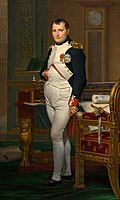
The Hundred Days, also known as the War of the Seventh Coalition, marked the period between Napoleon's return from eleven months of exile on the island of Elba to Paris on 20 March 1815 and the second restoration of King Louis XVIII on 8 July 1815. This period saw the War of the Seventh Coalition, and includes the Waterloo Campaign, the Neapolitan War as well as several other minor campaigns. The phrase les Cent Jours was first used by the prefect of Paris, Gaspard, comte de Chabrol, in his speech welcoming the king back to Paris on 8 July.
Events from the year 1815 in France.

The First Cabinet of Napoleon I was appointed by the Emperor Napoleon I upon the establishment of the First French Empire on 18 May 1804, replacing the Cabinet of the Consulate. It was succeeded by the French Provisional Government of 1814 following the downfall of Napoleon and the abolition of the Empire.
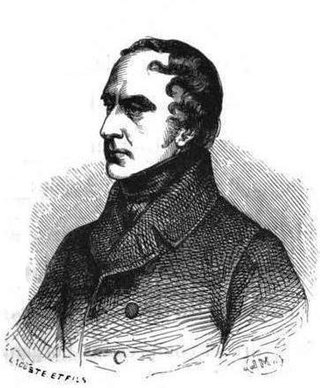
The Cabinet of François-Pierre Guizot was the last ministry of King Louis Philippe I of France, formed by decree of 19 September 1847. It replaced the Third cabinet of Nicolas Jean-de-Dieu Soult. It was dissolved when the Provisional Government was formed on 24 February 1848 after the February Revolution.
The Paris Municipal Commission Ministry of 1830 was proclaimed by the Paris Municipal Commission on 31 July 1830, after the revolution in which the Bourbon Restoration monarchy was deposed. One day later, it was replaced by a provisional government named by Louis Philippe I of Orléans.
The French Provisional Ministry of 1830 was announced on 1 August 1830 by Louis-Philippe d'Orléans in his capacity as Lieutenant General of the kingdom. It replaced the Paris Municipal Commission Ministry announced the day before after the revolution in which the Bourbon Restoration monarchy was deposed. On 11 August 1830 it was replaced by the First ministry of Louis-Philippe.
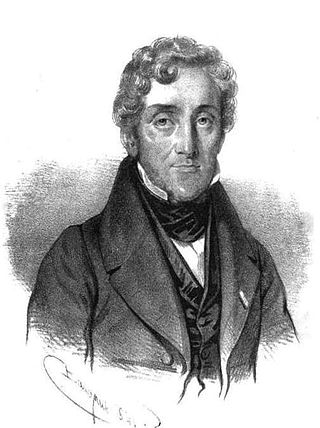
The Second cabinet of Louis Mathieu Molé was announced on 15 April 1837 by King Louis Philippe I. It replaced the First cabinet of Louis Mathieu Molé.

Jean Lacave-Laplagne was a French magistrate and politician.
The Transitional French cabinet of 1839 was announced on 31 March 1839 by King Louis Philippe I. It replaced the Second cabinet of Louis Mathieu Molé.

The Second cabinet of Nicolas Jean-de-Dieu Soult was announced on 12 May 1839 by King Louis Philippe I. It replaced the Transitional French cabinet of 1839.

The Ministry of Casimir de Rochechouart de Mortemart was announced on 29 July 1830 by King Charles X of France during the last day of the Bourbon Restoration. Later that day the ministry was replaced by the Paris Municipal Commission.
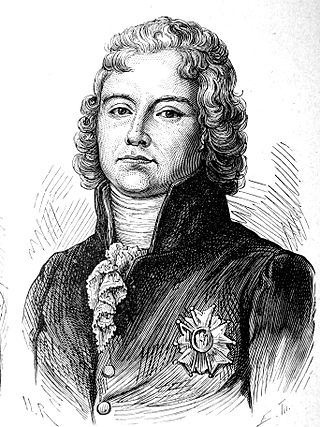
The Ministry of Charles-Maurice de Talleyrand-Périgord was formed on 9 July 1815 after the second Bourbon Restoration under King Louis XVIII of France. It replaced the French Provisional Government of 1815 that had been formed when Napoleon abdicated after the Battle of Waterloo. The cabinet was dissolved on 26 September 1815 and replaced by the First ministry of Armand-Emmanuel du Plessis de Richelieu.

The First ministry of Armand-Emmanuel du Plessis de Richelieu was formed on 26 September 1815 after the dismissal of the Ministry of Charles-Maurice de Talleyrand-Périgord by King Louis XVIII of France. It was dissolved on 29 December 1818 and replaced by the Ministry of Jean-Joseph Dessolles.

The Ministry of Joseph de Villèle was formed on 14 December 1821 after the dismissal of the Second ministry of Armand-Emmanuel du Plessis de Richelieu by King Louis XVIII of France.
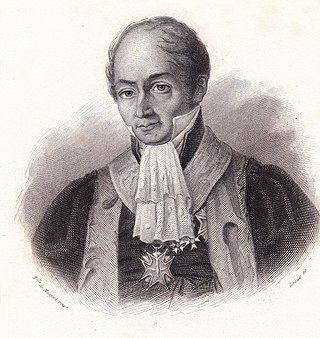
Pierre François Hercule de Serre was a French soldier, lawyer and politician. He was a deputy from 1815 to 1824, and was Minister of Justice in three successive cabinets from 1818 to 1821. He sat on the center-right, but had liberal views on press freedom, direct elections and the use of juries.
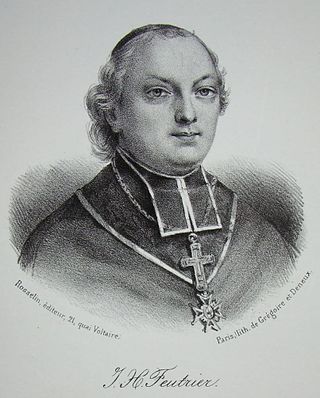
François-Jean-Hyacinthe Feutrier was a French Catholic priest who became Bishop of Beauvais. He was Minister of Religious Affairs from 3 March to 8 August 1829. He caused a storm of protest from the other bishops in France when he signed an ordinance aimed at restricting the influence of the church in schools.

The Government of the first Bourbon restoration replaced the French provisional government of 1814 that had been formed after the fall of Napoleon. It was announced on 13 May 1814 by King Louis XVIII. After the return of Napoleon from exile, the court fled to Ghent and the government was replaced by the French Government of the Hundred Days on 20 March 1815.

The French Provisional Government of 1814 held office during the transitional period between the defeat of Napoleon followed by the surrender of Paris on 31 March 1814 and the appointment on 13 May 1814 of the Government of the first Bourbon restoration by King Louis XVIII of France.

The French Provisional Government or French Executive Commission of 1815 replaced the French government of the Hundred Days that had been formed by Napoleon after his return from exile on Elba. It was formed on 22 June 1815 after the abdication of Napoleon following his defeat at the Battle of Waterloo.

Pierre Paul Nicolas Henrion de Pansey was a French jurist and politician. He was briefly Minister of Justice in the French provisional government of 1814 formed after the defeat of Napoleon. He was one of the presidents of the Court of Cassation, a final court of appeal in France. He wrote several major works on jurisprudence.
